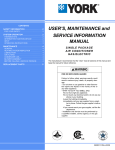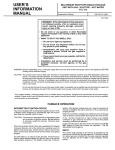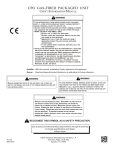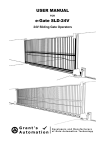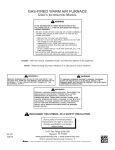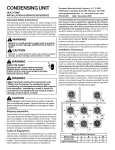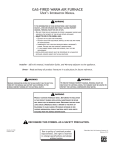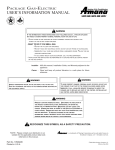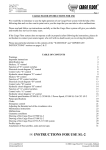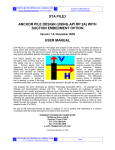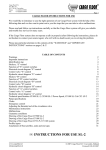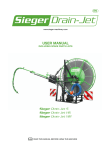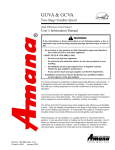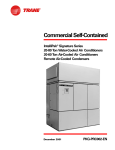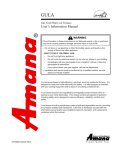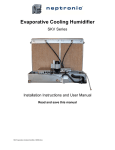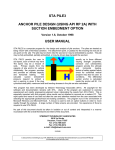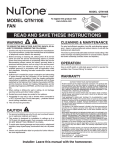Download User Info - Johnstone Supply
Transcript
GAS-FIRED FURNACE PACKAGED ROOFTOP SYSTEMS MODELS PGB & PGC 090-180 USER’S INFORMATION MANUAL WARNING IF THE INFORMATION IN THESE INSTRUCTIONS IS NOT FOLLOWED EXACTLY, A FIRE OR EXPLOSION MAY RESULT CAUSING PROPERTY DAMAGE, PERSONAL INJURY OR LOSS OF LIFE. – TO PREVENT THE RISK OF PROPERTY DAMAGE, PERSONAL INJURY, OR DEATH, DO NOT STORE COMBUSTIBLE MATERIALS OR USE GASOLINE OR OTHER FLAMMABLE LIQUIDS OR VAPORS IN THE ® VICINITY OF THIS APPLIANCE. – WHAT TO DO IF YOU SMELL GAS: • DO NOT TRY TO LIGHT ANY APPLIANCE. • DO NOT TOUCH ANY ELECTRICAL SWITCH; DO NOT USE ANY PHONE IN YOUR BUILDING. • IMMEDIATELY CALL YOUR GAS SUPPLIER FROM A NEIGHBOR’S PHONE. FOLLOW THE GAS US C SUPPLIER’S INSTRUCTIONS. • IF YOU CANNOT REACH YOUR GAS SUPPLIER, CALL THE FIRE DEPARTMENT. – INSTALLATION AND SERVICE MUST BE PERFORMED BY A QUALIFIED INSTALLER, SERVICE AGENCY ONLY INDIVIDUALS MEETING THE REQUIREMENTS OF AN "ENTRY LEVEL OR THE GAS SUPPLIER. TECHNICIAN" AS SPECIFIED BY THE AIR CONDITIONING AND REFRIGERATION INSTITUTE (ARI) MAY USE THIS INFORMATION. ATTEMPTING TO INSTALL OR REPAIR THIS UNIT WITHOUT SUCH BACKGROUND MAY RESULT IN PRODUCT DAMAGE, PERSONAL INJURY, OR DEATH. Installer - Affix this manual, Installation Guide, and Warranty adjacent to the appliance. Owner - Read and keep all product literature in a safe place for future reference. W ARN ING WARNING SHUT OFF THE MANUAL GAS VALVE TO THE FURNACE BEFORE SHUTTING OFF HIGH VOLTAGE! DISCONNECT ALL POWER BEFORE INSTALLING OR SERVICING. THE ELECTRICAL SUPPLY. POWER SOURCES MAY BE PRESENT. FAILURE TO DO SO MAY CAUSE SHOULD OVERHEATING OCCUR, OR THE GAS SUPPLY FAIL TO SHUT OFF, MULTIPLE PROPERTY DAMAGE, PERSONAL INJURY, OR DEATH. WARNING PRODUCT CONTAINS FIBERGLASS WOOL. DISTURBING THE INSULATION IN WARNING THIS PRODUCT DURING INSTALLATION, MAINTENANCE, OR REPAIR WILL BREATHING THIS MAY CAUSE LUNG CANCER. (FIBERGLASS WOOL IS KNOWN TO THE STATE OF CALIFORNIA TO CAUSE CANCER.) FIBERGLASS WOOL MAY ALSO CAUSE RESPIRATORY, SKIN, AND EYE IRRITATION. TO REDUCE EXPOSURE OR FOR FURTHER EXPOSE YOU TO FIBERGLASS WOOL. TO AVOID PROPERTY DAMAGE, PERSONAL INJURY OR DEATH, DO NOT USE THIS FURNACE IF ANY PART OF THE FURNACE HAS BEEN UNDER WATER. IMMEDIATELY CALL A QUALIFIED SERVICE TECHNICIAN TO INSPECT THE INFORMATION, CONSULT MATERIAL SAFETY DATA SHEETS AVAILABLE FROM FURNACE AND TO REPLACE ANY PART OF THE CONTROL SYSTEM AND ANY ADDRESS SHOWN BELOW. GAS CONTROL HAVING BEEN UNDER WATER. RECOGNIZE THIS SYMBOL AS A SAFETY PRECAUTION. Due to policy of continual product improvement, the right is reserved to change specifications and design without notice. Part No. HI-118 Printed in USA ©2005 Goodman Manufacturing Company, L.P. Effective: November 2005 INTRODUCTION WARNING The intent of this bulletin is to acquaint the user with some of the mechanical features and adjustments of the rooftop gas fired air conditioning units. In addition, the information contained in this manual is designed to identify any hazards and to serve as a guide to the user in the event of any malfunctions. FURNACE MUST NOT BE OPERATED IN AN ATMOSPHERE CONTAMINATED WITH HALOGENATED HYDROCARBON VAPORS, SOLVENT VAPORS OR ACID VAPORS. EXPOSURE TO THESE ATMOSPHERES MAY CAUSE SEVERE DAMAGE TO THE GAS FURNACE AND RESULT IN IMPROPER OR DANGEROUS DO’S AND DO NOT’S OPERATION. OPERATION OF THE GAS FURNACE IN SUCH A CONTAMINATED ATMOSPHERE CONSTITUTES PRODUCT ABUSE. DO read the User’s Manual and Installation Instructions before operating the unit. IMPORTANT NOTE TO THE OWNER DO have your heating and cooling unit serviced at least once a year. It is strongly recommended that the unit be inspected and serviced by a qualified service agency at the beginning of each heating and cooling season. Your warranty certificate is supplied with the unit. Read the warranty carefully and note what is covered. Keep the warranty certificate in a safe place, so you can find it, if necessary. Before using this manual, check the serial plate for proper model identification. NOTE: Additional periodic maintenance is recommended. Refer to “Maintenance” section. The installation and servicing of this equipment must be performed by qualified, experienced technicians only. DO NOT attempt to alter the unit. DO NOT block or obstruct the furnace air inlets or outlets. SAFETY INSTRUCTIONS DO NOT tamper with the internal fan and limit control mechanisms. DO NOT use any type of fuel other than indicated on the unit’s nameplate. WARNING SAFETY T HIS FURNACE IS EQUIPPED WITH AN ELECTRIC IGNITION. DO NOT SIGNAL WORDS ATTEMPT TO LIGHT THE FURNACE MANUALLY WITH A MATCH OR OTHER Dear Homeowner, please recognize the following safety information. This information will alert you to the potential for personal injury. LIGHTING MEANS. A. BEFORE OPERATING, it is recommended to use a leak detector to check for gas leaks. If one is not available, smell all around the appliance area for gas. Be sure to smell next to the floor because some gas is heavier than air and will settle to the floor. WARNING - Indicate hazards or unsafe practices which COULD result in property damage, product damage, personal injury or death. WARNING CAUTION - Indicate hazards or unsafe practices which MAY result in in property damage, product damage, personal injury or death. AN UNDETECTED GAS LEAK WILL CREATE A DANGER OF EXPLOSION OR FIRE. IF THE PRESENCE OF GAS IS SUSPECTED, FOLLOW THE INSTRUCTIONS ON THE COVER OF THIS MANUAL. FAILURE TO DO SO COULD RESULT IN SERIOUS PERSONAL INJURY OR DEATH. WARNING THIS PRODUCT CONTAINS OR PRODUCES A CHEMICAL OR CHEMICALS WHICH MAY CAUSE SERIOUS ILLNESS OR DEATH AND WHICH ARE KNOWN TO THE WARNING STATE OF CALIFORNIA TO CAUSE CANCER, BIRTH DEFECTS OR OTHER – REPRODUCTIVE HARM. WARNING WHAT TO DO IF YOU SMELL GAS: • DO NOT TRY TO LIGHT ANY APPLIANCE. • DO NOT TOUCH ANY ELECTRICAL SWITCH; DO NOT USE ANY PHONE IN YOUR BUILDING. • IMMEDIATELY CALL YOUR GAS SUPPLIER FROM A NEIGHBOR’S PHONE. FOLLOW THE GAS SUPPLIER’S INSTRUCTIONS. • IF YOU CANNOT REACH YOUR GAS SUPPLIER, CALL THE FIRE DEPARTMENT. TO AVOID POSSIBLE EQUIPMENT DAMAGE, PERSONAL INJURY, FIRE OR DEATH, THE FOLLOWING INSTRUCTIONS MUST BE OBSERVED REGARDING UNIT B. Use only your hand to push in or turn the gas control knob. NEVER use tools. If the knob will not push in or turn by hand, don’t try to repair it; call a qualified service technician. Force or attempted repair may result in a fire or explosion. LOCATION, AIR REQUIREMENTS AND OPERATING PROCEDURES. WARNING UNIT LOCATION HEATING UNIT SHOULD NOT BE UTILIZED WITHOUT REASONABLE, ROUTINE, INSPECTION, MAINTENANCE AND SUPERVISION. IF THE BUILIDNG IN WHICH ANY These units are designed for outdoor installation only, either on a slab just above ground level or on a rooftop. The unit should be protected from access by unauthorized persons or children. SUCH DEVICE IS LOCATED WILL BE VACANT, CARE SHOULD BE TAKEN THAT SUCH DEVICE IS ROUTINELY INSPECTED, MAINTAINED AND MONITORED. IN THE EVENT THAT THE BUILDING MAYBE EXPOSED TO FREEZING TEMPERATURES At no time should an enclosure be constructed around the unit that will prevent free air circulation or interfere with venting the flue AND WILL BE VACANT, ALL WATER-BEARING PIPES SHOULD BE DRAINED, THE BUILDING SHOULD BE PROPERLY WINTERIZED, AND THE WATER SOURCE CLOSED. IN THE EVENT THAT THE BUILDING MAY BE EXPOSED TO FREEZING TEMPERATURES AND WILL BE VACANT, ANY HYDRONIC COIL UNITS SHOULD BE DRAINED AS WELL AND, IN SUCH CASE, ALTERNATIVE HEAT SOURCES SHOULD BE UTILIZED. 2 discharge. An enclosure, overhang or obstruction shall not be placed above the unit. Units installed next to a wall are likely to experience backdrafts from adjacent walls. 5. Remove control access panel to expose gas control, if necessary. 6. Turn gas control switch or knob clockwise to “OFF”. NOTE: The White-Rodgers valve cannot be turned to “OFF” unless the knob is pushed in slightly at the black mark. Do not force. The furnace requires air for combustion of the gas. Therefore, DO NOT block or obstruct the air or vent openings to the furnace. Keep 7. Wait five (5) minutes to clear out any gas. If you then smell gas, the area surrounding the furnace free from debris and snow. A vent STOP! Follow step “A” in Safety Instructions. If you don’t smell stack is not required, and must never be used. gas, go to next step. FURNACE AIR AND FLUE VENTING REQUIREMENTS 8. Turn gas control switch or knob counterclockwise to “ON”. The knob has a safety latch to prevent accidental repositioning to “ON”. The knob will hit a stop before it reaches “ON”. To continue to turn the knob to “ON”: the Honeywell valve knob must be pushed down or the White-Rodgers valve knob must be released to allow it to “POP-UP” then continue turning to “ON”. CAUTION DO NOT INSTALL UNIT NEXT TO WINDOWS. RECOMMENDED CLEARANCES 9. Replace control access panel. DO NOT omit any screws when replacing panel. As shown in Figure 1, a 36” clearance must be maintained on the furnace access side of the unit. This clearance must be maintained for accessibility and to allow proper combustion air and flue gas flow. This clearance must be kept free of any combustible material. WARNING E XCEPT DURING BRIEF PERIODS WHEN GAS PRESSURES ARE BEING MEASURED BY QUALIFIED SERVICE PERSONNEL, THE FURNACE ACCESS PANEL MUST BE IN PLACE AT ALL TIMES WHEN FURNACE IS OPERATING. 10. Turn on all electric power to the appliance. 11. Set thermostat or controller to desired setting. 12. If the appliance will not operate, follow the instructions “To Turn Off Gas To Appliance” and call your service technician or gas supplier. TO TURN OFF GAS TO APPLIANCE: NOTE: UNIT FOOTPRINT IS 74 /16" x 74 /16" 9 9 W ARN ING Figure 1. Service Clearances HIGH VOLTAGE! DISCONNECT ALL POWER BEFORE INSTALLING OR SERVICING. MULTIPLE It is recommended that a 75” clearance be maintained on the POWER SOURCES MAY BE PRESENT. FAILURE TO DO SO MAY CAUSE furnace access side of the unit to facilitate possible furnace or PROPERTY DAMAGE, PERSONAL INJURY, OR DEATH. blower shaft removal. It is recommended that at least 48” clearance be maintained around the other three sides of the unit to facilitate air circulation and to allow service access to the unit 1. Set the thermostat or controller to lowest setting or tun off power at switch. filters and mechanical components. 2. Turn off all electrical power to the appliance if service is to be These clearances are greater than those shown on the unit performed. dataplate, which are minimum clearances to combustible sur3. Remove control access panel. faces for safety. 4. Turn gas control switch or knob clockwise until it stops at marking. Push in slightly and turn clockwise to “OFF”. OPERATING INSTRUCTIONS 5. Replace control access panel. W ARN ING HIGH VOLTAGE! DISCONNECT ALL POWER BEFORE INSTALLING OR SERVICING. MULTIPLE POWER SOURCES MAY BE PRESENT. FAILURE TO DO SO MAY CAUSE PROPERTY DAMAGE, PERSONAL INJURY, OR DEATH. 1. STOP! Read all safety information. 2. Set thermostat or heat control to lowest setting. 3. Turn off all electric power to the disconnect switch. 4. This appliance is equipped with an ignition device which automatically lights the burners. DO NOT try to light by hand. 3 FAILURE OF THE FURNACE TO OPERATE Honeywell Valve White-Rodgers Valve The furnace is provided with several safety control features which can prevent furnace operation. These controls may require a “RESET” action to resume normal operation. Gas Valve On/Off Selector Switch INLET OUTLET OUTLET INLET CAUTION FURNACE SAFETY CONTROLS THAT HAVE TRIPPED AND MUST BE MANUALLY RESET INDICATES A HIGH PROBABILITY OF A DANGEROUS PROBLEM. IF THIS Figure 2. Gas Valve OCCURS, IT IS MANDATORY THAT THE FURNACE BE INSPECTED BY A SEQUENCE OF OPERATION QUALIFIED SERVICE CONTRACTOR. 1. IGNITION CONTROL WARNING Reset by turning the system switch on the room thermostat to “OFF” and then back to “HEAT” or “AUTO”. This control can also be reset by turning the thermostat setting down and then back to the normal setting. LINE VOLTAGE NOW PRESENT. When the unit is provided with the proper electric power supply and the proper gas supply, the furnace will operate in the following sequence: The ignition control will close the gas valve and terminate spark if proof of ignition is not provided by the flame sensor within 4 to 7 seconds. The ignition control will allow 15 seconds of ventor fan operation and then try another ignition sequence. If the second ignition sequence fails, the ignition control will try a third sequence and if that fails, the control will lockout for an hour or must be reset as described above. Some of the conditions that can cause ignition failure are loss of gas supply, blockage of combustion air or flue passage, or malfunction within the burner compartment. With the room thermostat set at the “HEAT” or “AUTO” position, increasing the temperature setting or a drop in room temperature will signal the first stage of heat. 1. The furnace ventor fan operates. 2. The unit circulating air blower control begins timing and starts the blow in approximately twenty to thirty seconds. NOTE: If the fan switch on the thermostat panel is set to the “ON” position, the blower will operate continuously. 2. TEMPERATURE LIMIT CONTROLS 3. After a 15 second pre-purge period of ventor fan operation, the ignition spark is initiated and the gas valve is opened to the low stage. A. Furnace Limit: Automatic Reset. The furnace limit control will terminate furnace operation if the discharge air temperature exceeds the established limit setting. The limit will reset and allow the furnace to resume operation after a short off period. Some of the conditions that can cause the limit to trip are low air flow, loose belts, restricted ducts or dirty filters. 4. The ignition spark ignites the burner. WARNING T HIS FURNACE IS EQUIPPED WITH AN ELECTRIC IGNITION. B. Burner Roll-Out Limit: DO NOT ATTEMPT TO LIGHT THE FURNACE MANUALLY WITH A MATCH OR OTHER Manual reset required at unit (located in burner compartment above burners). LIGHTING MEANS. The burner roll-out limit control will terminate furnace operation if the burner compartment temperature exceeds the established limit setting. Some of the conditions that can cause the limit to trip are extremes in gas pressure, blockage of combustion air or flue discharge, a malfunction within the burner compartment or operation of the furnace with the access panel removed. 5. The flame sensor confirms that ignition of the burner has occurred and terminates the spark. 6. The furnace is now operating on low stage fire. 7. Increasing the thermostat setting or a further drop in room temperature energizes the second heat stage. 8. The gas valve slowly opens to the high stage (15 to 30 seconds). C. Reverse Airflow Limit: 9. The furnace is now operating at full heat output. Automatic reset required at unit (located in blower compartment on side opposite blower motor and drive). 10. Lowering the thermostat setting or an increase in room temperature will de-energize the high stage. The reverse airflow limit will terminate furnace operation if the blower and filter compartment temperature exceeds the established limit setting. Some of the conditions that can cause the limit to trip are loss of airflow from duct blockage, loss of drive belts or tripping of the blower motor overloads. 11. The high stage gas valve slowly closes and the furnace operates on low stage. 12. Lowering the thermostat setting further or a further increase in room temperature will de-energize the low heating stage. 13. The gas valve closes and combustion is terminated. 14. The ventor fan is de-energized. 15. The unit circulating blow control begins timing and terminates operation of the blower in 120 to 150 seconds. 4 W A R N IN G HIGH VOLTAGE! DISCONNECT ALL POWER BEFORE ATTEMPTING TO RESET WARNING CONTROLS. MULTIPLE POWER SOURCES MAY BE PRESENT. FAILURE TO DO HIGH VOLTAGE! THE FLAME SENSOR AND IGNITOR ELECTRODES CARRY VERY HIGH VOLTAGE. DISCONNECT ALL POWER BEFORE SERVICING UNIT. MULTIPLE POWER SO MAY CAUSE PROPERTY DAMAGE, PERSONAL INJURY, OR DEATH. SOURCES MAY BE PRESENT. FAILURE TO DO SO MAY CAUSE PROPERTY MANUAL LIMIT DAMAGE, PERSONAL INJURY, OR DEATH. FURNACE ACCESS PANEL WARNING E XCEPT DURING BRIEF PERIODS WHEN GAS PRESSURES ARE BEING MEASURED BY QUALIFIED SERVICE PERSONNEL, THE FURNACE ACCESS PANEL MUST BE IN PLACE AT ALL TIMES WHEN FURNACE IS OPERATING. Always replace the screws that hold the door in place. The access panel seals to the furnace ventor fan discharge by engagement of the panel sleeve into the fan outlet sleeve. Be sure that these sleeves are always in place and engaged to maintain safe furnace operation. Figure 4. Burner Assembly BURNER FLAME REQUIREMENTS The flame exits from the burner in a tubular shape and enters the furnace heat exchanger. The flame should be blue in color and should not lift away from the end of the burner. If the flame rolls out rather than entering the heat exchanger, the heat exchanger, flue passages and ventor assemblies may require inspection or cleaning. The carry over tube has a small flame approximately one half inch long and operates continuously during burner operating. Refer to “Maintenance” section in the installation instructions (IO-156) for cleaning procedure. Figure 3. Furnace Access Panel BURNER ASSEMBLY The burner assembly is removable for service or replacement of the gas valve. The assembly consists of the following major parts (See Figure 4): A. Gas Valve B. Gas Manifold C. Gas Orifices D. Burners E. Carry Over Tube F. Carry Over Orifice G. Ignitor Electrode H. Flame Sensor Electrode I. Burner Support The burner assembly must always be aligned and securely fastened in place with the upper and lower screws. Figure 5. Burner Flame 5 FILTERS PRIMARY AIR ADJUSTMENT The primary air shutters are factory set and normally do not require adjustment. If shutters are adjusted, no visible changes in the flame appearance will occur. One of two types of burners will be provided with the furnace. The shutters should be set and secured as shown in Figure 6 or 7. WARNING TO AVOID PROPERTY DAMAGE, PERSONAL INJURY OR DEATH, DISCONNECT ELECTRICAL POWER BEFORE REMOVING FILTERS. NEVER OPERATE FURNACE WITHOUT A FILTER INSTALLED BECAUSE DUST AND LINT WILL BUILD UP ON INTERNAL PARTS RESULTING IN LOSS OF EFFICIENCY, EQUIPMENT DAMAGE AND POSSIBLE FIRE. Every application may require a different frequency of replacement of dirty filters. Filters must be inspected, cleaned or changed every three months or as required. As a homeowner, it is your personal responsibility to keep air filters clean. Remember that dirty filters are the most common cause of inadequate heating or cooling performance. Filters supplied with the units are the disposable type and are as follows: Figure 6. Type l Burner UNIT SIZE QTY. FILTER SIZE PART NUMBER (ONE FILTER) 090-102 3 25X25X2 B1369612 3 16X25X2 B1369610 3 20X25X2 B1369611 120-180 Become familiar with filter location and procedures for removing, cleaning and replacing them. If you need assistance, contact the installer of your furnace or another qualified servicer. TO REPLACE FILTERS Remove the filter access panel on either or both sides of the unit. See Figure 8. Filters are three deep and slide in and out. Always replace the panels and screws before operating the unit. Disposable filters must be replaced with a filter or filters of the same size as that which is removed. Filters must comply with UL900 or CAN/ULC-S111 Standards. Figure 7. Type II Burner When reinstalling filters, be careful to maintain correct airflow direction. ROUTINE MAINTENANCE Maintenance is to be performed by a qualified service technician only. User maintenance is to be restricted to frequent air filter changes and to ensure the warnings and notices found elsewhere in this manual be followed. We recommend that at a minimum system maintenance be performed by a qualified service technician prior to the beginning of each heating season, and if equipped with air conditioning prior to that season. WARNING PERSONAL INJURY OR DEATH MAY RESULT FROM IMPROPER MAINTENANCE CALL YOUR INSTALLING DEALER PERFORMED BY UNTRAINED PERSONNEL. OR OTHER QUALIFIED SERVICE COMPANIES TO PERFORM THE MAINTENANCE INSPECTION. WARNING Figure 8. Filter Access TO AVOID PERSONAL INJURY OR DEATH DUE TO ELECTRICAL SHOCK, DISCONNECT THE ELECTRICAL POWER BEFORE PERFORMING ANY MAINTENANCE. 6 LUBRICATION INSTRUCTIONS FOR PERIODIC INSPECTION OF THE To lubricate the ventor motor, remove the furnace access panel. FURNACE Lubricate the motor in two locations as shown in Figure 9. Use SAE 20W lubricant and add five drops to each location. The motor WARNING should be lubricated at the beginning of each heating season. DO NOT OVER LUBRICATE. IMPROPER INSTALLATION, ADJUSTMENT, ALTERATION, SERVICING OR MAINTENANCE CAN CAUSE PROPERTY DAMAGE, PERSONAL INJURY OR DEATH. WARNING DO NOT DRIP OIL ANNUAL INSPECTION The furnace should be inspected by a qualified installer, or service agency at least once per year. This check should be performed at the beginning of the heating season and periodically during the season. This will insure that all furnace components are in proper working order and that the heating system functions appropriately. Particular attention should be paid to the following items. Repair as necessary. ON THE GAS VALVE. THE OIL MAY DAMAGE THE NON-METALLIC PARTS AND RENDER THE VALVE INOPERABLE. REMOVE ANY OIL RESIDUES FROM THE BURNER COMPARTMENT. • The physical support of the furnace should be sound without sagging, cracks, gasp, etc., around the base to provide a seal between the support and the base. • Flue pipe system. Check for blockage and/or leakage. Check the outside termination and the connections at and internal to the furnace. • The return air duct connection should be physically sound and sealed to the furnace casing. • Burners. Check for proper ignition, burner flame, and flame sense. Flames should extend directly outward from burners without curling, floating or lifting off. • Wiring. Check electrical connections for tightness and/or corrosion. Check wires for damage. • Filters. Check that filters are clean and in the proper placement in the furnace or duct system. Figure 9. Ventor Motor • Remove the furnace access panel and visually inspect the burner area and vent fan outlet for corrosion, corrosion particles, or soot. There should be no obvious signs of deterioation of the furnace. If any evidence of deterioration is observed, contact a qualified service agency. NOTE: Information regarding the inspection and cleaning of the burners and flue gas passagemways is included in the “Maintenance” section of the Installation Instructions (IO-156). 7 SAFETY LABELS FOR YOUR SAFETY READ BEFORE OPERATING WARNING A. This appliance does not have a pilot. It is equipped with an ignition device which automatically lights the burners. Do not try to light the burners by hand. B. BEFORE OPERATING smell around the appliance area for gas. Be sure to smell next to the floor because some gas is heavier than air and will settle on the floor. WHAT TO DO IF YOU SMELL GAS Do not try to light any appliance. Do not touch any electric switch; do not use any telephone in your building. Immediately call your supplier from a neighbor's phone. Follow the gas suppliers instructions. If you do not follow these instructions exactly, a fire or explosion may result causing property damage, personal injury or loss of life. If you cannot reach your gas supplier, call the fire department. C. Use only your hand to move the gas control switch or knob. Never use tools. If the gas control switch or knob will not operate, don't try to repair it, call a qualified service technician. Force or attempted repair may result in a fire or explosion. D. Do not use this appliance if any part has been under water. Immediately call a qualified service technician to inspect the appliance and to replace any part of the control system and any gas control which has been under water. WARNING: Improper installation, adjustment, alteration, service or maintenance can cause injury or property damage. Refer to the user's information manual provided with this furnace. For assistance or additional information consult a qualified installer, service agency or the gas supplier. This furnace must be installed in accordance with the manufacturers instructions and local codes. In the absence of local codes, follow the National Fuel Gas Code, ANSI Z223.1. OPERATING INSTRUCTIONS 1. STOP! Read the safety information above on this label. 2. Set the thermostat to lowest setting. 3. Turn off all electric power to the appliance. 4. This appliance is equipped with an automatic ignition system which automatically lights the burners. Do not try to light the burners by hand. 5. Remove control access panel. 6. Move the gas control switch or knob to "OFF". GAS CONTROL SWITCH SHOWN IN "ON" POSITION 7. Wait five (5) minutes to clear out any gas. If you then smell gas, STOP! Follow "B" in the safety information above on this label. If you don't smell gas, go to the next step. 8. Move the gas control switch or knob to "ON". 9. Replace control access panel. 10. Turn on all electric power to the appliance. 11. Set the thermostat to the desired setting. 12. If the appliance will not operate, follow the instructions "To Turn Off Gas To Appliance" and call your service technician or gas supplier. KNOB ON OFF GAS CONTROL GAS CONTROL SWITCH SHOWN IN "ON" POSITION TO TURN OFF GAS TO APPLIANCE 1. Set the thermostat to its lowest setting. 2. Turn off all electric power to the appliance if service is to be performed. 3. Remove control access panel. For outdoor installation only. 4. Move the gas control switch or knob to "OFF". Do not force. 5. Replace control access panel. WARNING: If not installed, operated and maintained in accordance with the manufacturer's instructions, this product could expose you to substances in fuel combustion which can cause death or serious illness and which are known to the State of California to cause cancer, birth defects or other reproductive harm. This product contains fiberglass insulation. Fiberglass insulation contains a chemical known by the State of California to cause cancer. FOR YOUR SAFETY Do not store or use gasoline or other flammable vapors and liquids in the vicinity of this or any other appliance. B14933-247 CONSUMER INFORMATION LINE TOLL FREE 1-877-254-4729 (U.S. only) email us at: [email protected] fax us at: (731) 856-1821 For convenience, record the Model, Manufacturing Number and Serial Number of the unit found on the nameplate of the furnace MODEL NUMBER: _ _ _ _ _ _ _ _ _ _ _ (Not a technical assistance line for dealers.) MANUFACTURING NUMBER: _ _ _ _ _ _ _ _ Outside the U.S., call 1-713-861-2500. (Not a technical assistance line for dealers.) Your telephone company will bill you for the call. ©2005 Goodman Manufacturing Company, L.P. SERIAL NUMBER: _ _ _ _ _ _ _ _ _ _ 8 November 2005








